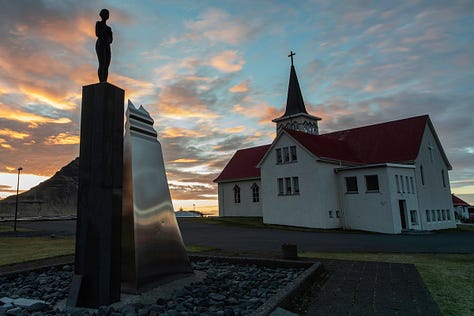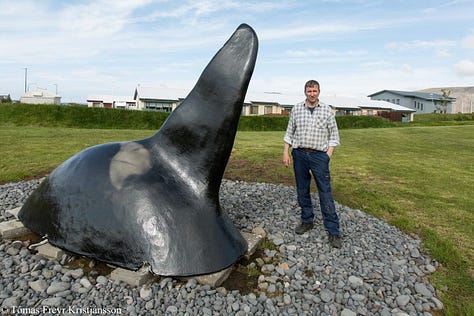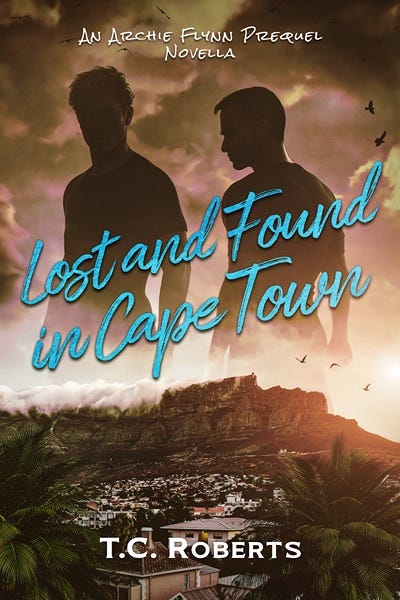Four Hours in Grundarfjordur, Iceland
Where the Locals Won't Build a House if an Elf Already Lives There
Our first three stops on the Norwegian Star cruise line brought us to Nova Scotia, Newfoundland and Labrador, and Greenland where I discovered bomb shrapnel, dog breeds, and a must-not-visit chocolate factory, respectively.
The balance of the Norwegian Star’s ports of call, three in all, were in Iceland. Most visitors concentrate on the swoop of Ring Road that hugs the southern coast from the capital city of Reykjavik to Hofn in the east. The ship’s itinerary would bring us to the less-often visited north and west of the island.
In the wee hours of the morning, the cruise ship made an unscheduled visit in the capital city to off-load a man whose vape pen exploded and caused severe facial burns. At least that was the scuttlebutt at breakfast when the captain announced that we’d no longer have time for Isafjordur.
Furthermore, the ship lost its berth at Grundarfjordur. What was supposed to be a walk-off-the-ship port now required a tender ride to shore. I hate tenders. The wait times for the little boats further reduce the already limited time on shore. I find it so irksome that the number of tender ports is one of the factors I consider when choosing a cruise. I landed onshore at Grundarfjordur with the 16th of 17 groups, three hours after we docked.
The town is tiny, about 900 persons. The big draw of the area is Kirkjufell, or Church Mountain—the most photographed mountain in Iceland—and the river with three waterfalls of the same name.
Game of Thrones fans might recognize the silhouette from Season 6 episode 5 where the Night King was created to protect the Children of the Forest, or Season 7 episode 6 when Jon Snow, the Hound, and companions pass the mountain beyond the Wall to confront the White Walkers.
The return trip to the waterfall is about a four-mile walk. I enjoyed the walk, but if I’d had to do it over, I’d have stopped at the viewpoint noted on the map instead. The waterfalls were covered in hundreds of people. If a photo is what you’re after, buy a postcard and use the spare time to visit the nearby Shark Museum of Bjarnarhofn to learn more about hakarl, the legendary national dish of Iceland.
Hakarl is Greenland shark, a creature that is poisonous for human consumption due in part to its high urea content. When left to ferment on the sand beneath rocks for several weeks, and subsequently dried for months, however, it becomes edible. Whether or not it is enjoyable is up to personal taste.
On the walk back, I veered into town to check out the church and nearby sculpture.
There are three sculptures in the church’s vicinity: a fisherwoman looking out to sea, the fin of an orca diving into the ground, and spooling wooden planks with 112 of the more than 130 Icelandic words for wind.



Perhaps the most interesting find of all can also be found near the church. Locate the unassuming three boulders and introduce yourself to the resident “Hidden” people.
Grundarfjordur is, as far as I could tell from a cursory Google search, the only place in the world that has allocated vacant land to the “Hidden” people of Iceland. That is, the ancient, indigenous, magical creatures known as elves and dwarves. The municipal map below indicates those lots where the hidden people already live, if you’d like to introduce yourself to the whole community.

The final stop on my walking tour of Grundarfjordur took me to the local supermarket, Samkaup, to scour the shelves for some local delicacies NOT made of fermented shark meat. Here, I found a rack of Icelandic mittens made in Iceland of Icelandic wool for about US 15 dollars. A steal. The pop-up shops near the cruise ship were selling homemade sweaters ($200) and gloves ($50) that were out of my budget.
They kept me nice and warm for the hour-long tender wait back to the ship, and during our parting views of the sleepy, western-Icelandic town.













